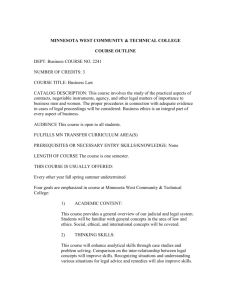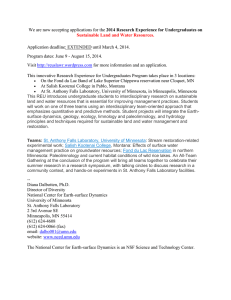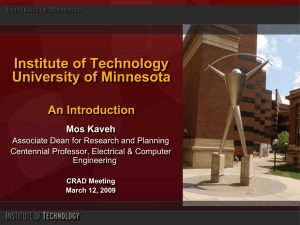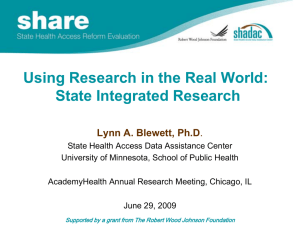Nuts and Bolts parent fam comm
advertisement
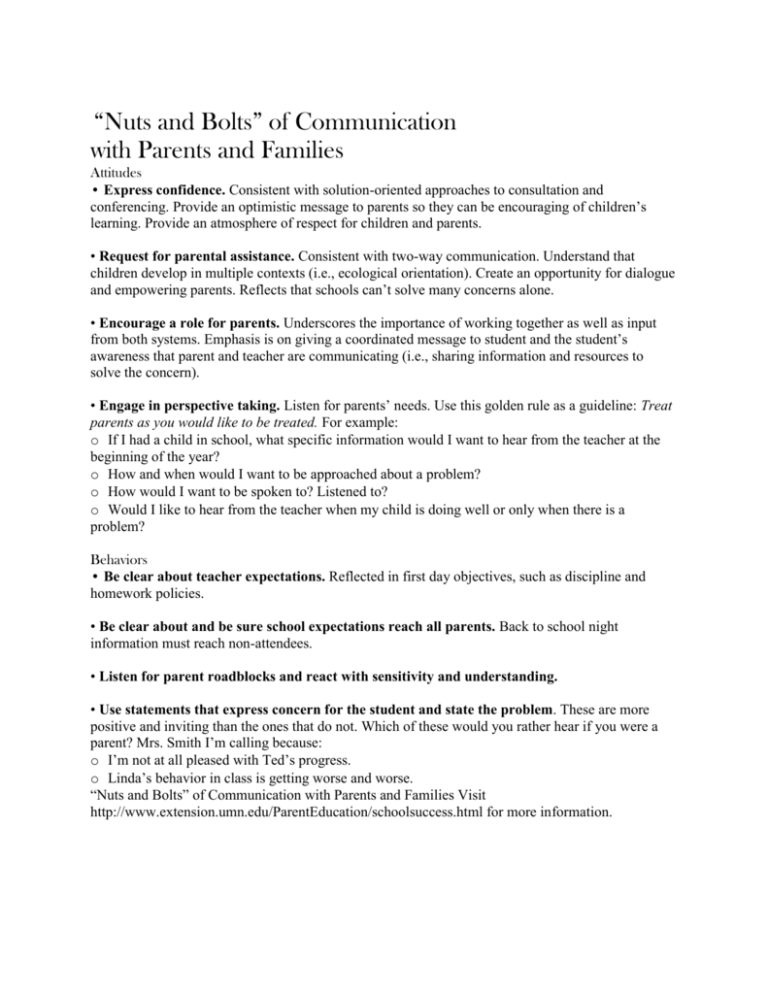
“Nuts and Bolts” of Communication with Parents and Families Attitudes • Express confidence. Consistent with solution-oriented approaches to consultation and conferencing. Provide an optimistic message to parents so they can be encouraging of children’s learning. Provide an atmosphere of respect for children and parents. • Request for parental assistance. Consistent with two-way communication. Understand that children develop in multiple contexts (i.e., ecological orientation). Create an opportunity for dialogue and empowering parents. Reflects that schools can’t solve many concerns alone. • Encourage a role for parents. Underscores the importance of working together as well as input from both systems. Emphasis is on giving a coordinated message to student and the student’s awareness that parent and teacher are communicating (i.e., sharing information and resources to solve the concern). • Engage in perspective taking. Listen for parents’ needs. Use this golden rule as a guideline: Treat parents as you would like to be treated. For example: o If I had a child in school, what specific information would I want to hear from the teacher at the beginning of the year? o How and when would I want to be approached about a problem? o How would I want to be spoken to? Listened to? o Would I like to hear from the teacher when my child is doing well or only when there is a problem? Behaviors • Be clear about teacher expectations. Reflected in first day objectives, such as discipline and homework policies. • Be clear about and be sure school expectations reach all parents. Back to school night information must reach non-attendees. • Listen for parent roadblocks and react with sensitivity and understanding. • Use statements that express concern for the student and state the problem. These are more positive and inviting than the ones that do not. Which of these would you rather hear if you were a parent? Mrs. Smith I’m calling because: o I’m not at all pleased with Ted’s progress. o Linda’s behavior in class is getting worse and worse. “Nuts and Bolts” of Communication with Parents and Families Visit http://www.extension.umn.edu/ParentEducation/schoolsuccess.html for more information. OR o I’m concerned about how little work Jess is doing. o I’m concerned about how Brian gets along with the other students. • Develop positive communication with parents. Examples include: o Positive phone calls. Describe student’s positive behavior. Describe how you feel about the behavior. Ask the parent to share the content of the conversation with the student. o Send a before school greeting or introductory letter. o Open verbal communication with parents of potential problem students. o Communicate at the first sign of a problem (phone call) and set up a parent problem-solving conference. o Schedule time for positive communication. One strategy is 360 phone calls in 36 weeks. (Teacher makes 10 calls per week. If there are 30 students, each family receives12 calls per school year.) Use good news postcards if no phones. o Other strategies include: notes, students keep a “school-to-home” journal, send student work home in a “Special Delivery to Parents” envelope, and weekly classroom newsletters. o End the year on a positive note. Send end of year note to students and/or make open house a parent thank you event. (Could students plan and feature what they have learned and their goals for next year?). Call parents with whom you have worked to solve problems. Always… • Develop a regular and reliable communication process. Communication needs to begin where families are. It should center on their interests, needs, and capabilities, not where you want them to be. It should be: o Timely. o Provide both a personal and general message. o Emphasize the positive but address concerns clearly and directly. o Give families information they need. o Be clear, concise, and free of jargon. o Documented on a regular basis. • Promote two-way exchanges of information. Consider whether you are communicating at mutually convenient times. To increase the potential for two-way communication: o Provide your telephone number on all communications. o Tell families how they can get in touch with you. o Practice active listening–during face-to-face and phone communications reiterate what you think the person is saying. Show that you are listening and understanding. Seek parent input and encourage them to share in the problem-solving process. Address parents’ concerns. o When setting up an intervention, ask the parent to join a partnership agreement with you. Each of you signs and commits to carrying our specific responsibilities for supporting the student’s learning. “Nuts and Bolts” of Communication with Parents and Families • Employ a variety of communication strategies. o Ask families about the form of communication they prefer: written notes, phone calls, or visits. o Plan communication and interventions to match family needs. o Use calendars, letters, and phone calls to help parents be aware of activities going on at school and activities that reinforce reading at home. • Employ a variety of strategies to enhance individual and personal communications. o The most powerful and meaningful communication strategies take place face- to-face or over the phone. Don’t rely solely on written communication. o Emphasize what the parent can do to achieve his/her goal for the child. Affirm the importance of the parent to the child’s engagement with reading and learning. o Provide parents with options. Invite the parent’s participation, explain the importance of the parent’s participation, and don’t mandate how the parent will be involved. Let the parent select. o Remember to thank parents for their involvement. • Remember the value of personal communication. Personal contact (home visits, phone calls, and personal notes) has been found to be most effective in reaching uninvolved families. Additionally, it is important to emphasize interest in the student and provide an optimistic message to parents. Reasons why personal communication may be more effective include: o Parents may not be able to read. o Parents are swamped with written communication. o Materials sent home from school with students doesn’t always make it home. o Personal communication is friendlier, more effective, and less formal. _____________________________________________________________________________ This has been taken from S. L. Christenson, C. Lehr, & L. Havsy’s (1998) Resource Manual for Schools' Engagement of Families (University of Minnesota, Check and Connect Project, Minneapolis, MN, not published). Permission to use for the Partnering for School Success project from the author. This has been reviewed (November 2009) by University of Minnesota Extension Educators: Kathleen Olson, Colleen Gengler, and Jo Musich; and University of Minnesota Children, Youth and Family Consortium Program Coordinator, Madge Alberts. Partnering for School Success is a joint project between the University of Minnesota Extension; University of Minnesota Children, Youth and Family Consortium; and key community leaders and organizations throughout Minnesota. It is funded in part by McKnight Foundation. For more information on the project, please visit http://www.extension.umn.edu/ParentEducation/schoolsuccess.html. This material is available in alternative formats upon request. Direct requests to 612-626-6602. University of Minnesota is an equal opportunity educator and employer.




